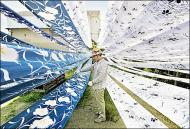Home > Press > Japan's textile-makers combine tradition with technology
 |
| A craftsman spreads his fabric out to dry |
Abstract:
Mother-of-pearl, wisteria and a deceptively blue butterfly from South America are part of a strategy to woo high-end fashion designers to discover the potential of Japanese textiles.
Japan's textile-makers combine tradition with technology
PARIS, France | Posted on February 10th, 2008A handful of highly specialised manufacturers and artisan weavers from Tango, in the region of Japan's ancient capital Kyoto, were in Paris last week to showcase their innovations, combining centuries-old tradition with the latest in nanotechnology.
Tango has long been famous for textiles because its wet climate favours the production of silk, particularly the crepe called "chirimen" used in kimonos. But technological advances are spurring the creation of new products with potential appeal outside Japan.
Initially it was the automaker Nissan which took an interest in the Morpho butterfly, which inhabits an area along the River Amazon. Its shiny cobalt blue colour in fact contains no blue pigment but is produced by the way it refracts light.
Nissan and Teijin Fibres initially explored the possibility of mimicking the butterfly's properties for a new kind of paint for cars but instead came up with a glossy material, Morphotex.
Without dyes or pigments, it creates the illusion of colour under light from the structure of its fibres. Using nanotechnology to control the thickness of the fibres, the fabric shows variations on red, green, blue and purple.
Toyota Tsusho, the textile arm of another car manufacturer, has also harnessed nanotechnology to develop a technique of weaving gold and silver threads into luxury denim, which it believes could find a future in haute couture.
New techniques are also enabling small-scale craftsmen to innovate and diversify, says Kyoji Tamiya of Tamiya Raden, whose father developed a way of weaving with mother-of-pearl inlays.
Shells are mounted on traditional Japanese paper in exquisite patterns, reminiscent of oriental pottery, which is then shredded to form the weft and woven with silk. From being used for elaborate obis or sashes to tie a kimono, he is branching out to use the precious fabric, which costs upwards of 350 euros a metre (510 dollars a yard) for handbags.
Mitsuyasu Koishihara's father, meanwhile, has revived an ancient technique of making textiles from the branch of the mountain wisteria. Once made all over Japan, it declined with the arrival of cotton and all but disappeared except in the Tango region.
"One day he saw this ama or Japanese sea woman (it is traditionally the women who dive for shells in Japan) and she had a bag made of something he didn't recognise. She said it was wisteria."
He set about rediscovering how to weave from it. Wild wisteria, which looks like raffia, is soft to the touch but twice as strong as linen. Their firm, Yushisha, is the only one specialising in wisteria textile making, which has now been designated a "cultural heritage of Kyoto".
As well as being used for obis, bags and norens, Japanese curtains decorating the entrance of shops, they are hoping their rare fabric will find a niche market in the West.
Other innovations shown in Paris included silks retaining the original stiffness with which the silk pupa protects itself from ultra-violet light, which is normally lost in the manufacturing process, and ultra-soft cottons made to a higher gauge than anywhere else in the world.
####
Copyright © AFP
If you have a comment, please Contact us.Issuers of news releases, not 7th Wave, Inc. or Nanotechnology Now, are solely responsible for the accuracy of the content.
| Related News Press |
News and information
![]() Simulating magnetization in a Heisenberg quantum spin chain April 5th, 2024
Simulating magnetization in a Heisenberg quantum spin chain April 5th, 2024
![]() NRL charters Navy’s quantum inertial navigation path to reduce drift April 5th, 2024
NRL charters Navy’s quantum inertial navigation path to reduce drift April 5th, 2024
![]() Discovery points path to flash-like memory for storing qubits: Rice find could hasten development of nonvolatile quantum memory April 5th, 2024
Discovery points path to flash-like memory for storing qubits: Rice find could hasten development of nonvolatile quantum memory April 5th, 2024
Announcements
![]() NRL charters Navy’s quantum inertial navigation path to reduce drift April 5th, 2024
NRL charters Navy’s quantum inertial navigation path to reduce drift April 5th, 2024
![]() Discovery points path to flash-like memory for storing qubits: Rice find could hasten development of nonvolatile quantum memory April 5th, 2024
Discovery points path to flash-like memory for storing qubits: Rice find could hasten development of nonvolatile quantum memory April 5th, 2024
Textiles/Clothing
![]() Protective equipment with graphene nanotubes meets the strictest ESD safety standards March 25th, 2022
Protective equipment with graphene nanotubes meets the strictest ESD safety standards March 25th, 2022
![]() Polymer fibers with graphene nanotubes make it possible to heat hard-to-reach, complex-shaped items February 11th, 2022
Polymer fibers with graphene nanotubes make it possible to heat hard-to-reach, complex-shaped items February 11th, 2022
![]() Flexible material shows potential for use in fabrics to heat, cool July 3rd, 2020
Flexible material shows potential for use in fabrics to heat, cool July 3rd, 2020
Events/Classes
![]() Researchers demonstrate co-propagation of quantum and classical signals: Study shows that quantum encryption can be implemented in existing fiber networks January 20th, 2023
Researchers demonstrate co-propagation of quantum and classical signals: Study shows that quantum encryption can be implemented in existing fiber networks January 20th, 2023
|
|
||
|
|
||
| The latest news from around the world, FREE | ||
|
|
||
|
|
||
| Premium Products | ||
|
|
||
|
Only the news you want to read!
Learn More |
||
|
|
||
|
Full-service, expert consulting
Learn More |
||
|
|
||








